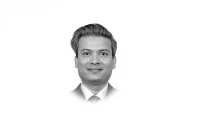The boundaries of our empathy
Authorities directed to treat women, children and the elderly with the utmost respect

“Authorities have been directed to treat women, children and the elderly with the utmost respect,” said the caretaker interior minister last week while talking about the holding centres as part of the country’s plan to deport millions of Afghans.
I have, in the past, written about the serious problems with that policy, and why it is both misguided on moral and ethical grounds and poor policy from a pragmatic perspective. Right now, however, my focus is on something else. It is not on what was said, but rather what was missing. While treating women, children and elderly with utmost respect is great and highly appropriate, why is our policy not including men? Why are they not entitled to respect? Why should they not be treated humanely?
What the minister said is quite common in international development conversations. I am fully on board with protecting women, elderly and children. Groups that may be vulnerable to exploitation or abuse should be protected at all costs and in all situations. I also recognise (and have written frequently) about the tragedies and evils of a patriarchal society like ours. Ours is a society where misogyny is the core part of our politics and the central theme in our humour. I consider myself a feminist and find male-dominated and male-centric policies in the country abhorrent and a source of much that is wrong in society. But I do find it objectionable that we are unable to articulate a policy that respects everyone and ensures dignity for every person, regardless of age or gender.
I have seen, first hand, what happens when policies that do not offer dignity to everyone are enacted. In May this year, I was visiting migration centres in Bosnia. These centres are supported by international organizations to provide basic health and support services to migrants, many of whom have faced awfully difficult circumstances during their long and painful journeys. The difference between centres that were designed for families and those designed only for men could not be starker. While the centres for families and women were lacking in a lot of areas, the centres that were designated for men were in a pitiful state. They looked and felt like a prison. The feeling was unmistakable and was felt by everyone in our team. The centres for migrant men were poorly run and poorly resourced. Migrants in those centres — even those who were suffering from trauma and mental illnesses — were treated awfully. It was a depressing site and it does not have to be this way.
My experiences at migration centers and camps are unfortunately not unique. There are numerous studies that have documented that the vulnerabilities of male refugees are often disregarded, and male refugees and displaced persons are not considered vulnerable. Studies from Balkans and Central America have demonstrated that humanitarian initiatives often do not incorporate physical and sexual abuse faced by male migrants and refugees in their policies and such instances often go unreported. Poorly designed policies can also result in family separation, where men may be separated from their spouses and children, thereby increasing the trauma for everyone. These policies also increase the risk of radicalisation and violence.
None of this is to say that women, children and elderly should not be treated well or with utmost respect. It is not to say that the trauma, violence and exploitation of women and children is somehow not important or should not be prioritized. It is simply to say that respect and dignified treatment should not have a ceiling or a boundary. My problem with the statements such as the one made by the minister is not that it went too far, but that it did not go far enough. Respect and dignity should encompass everyone, every single time.
Published in The Express Tribune, October 31st, 2023.
Like Opinion & Editorial on Facebook, follow @ETOpEd on Twitter to receive all updates on all our daily pieces.
















COMMENTS
Comments are moderated and generally will be posted if they are on-topic and not abusive.
For more information, please see our Comments FAQ